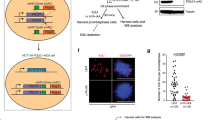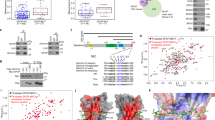Abstract
Origins of replication are activated throughout the S phase of the cell cycle such that some origins fire early and others fire late to ensure that each chromosome is completely replicated in a timely fashion. However, in response to DNA damage or replication fork stalling, eukaryotic cells block activation of unfired origins. Human cells derived from patients with ataxia telangiectasia are deficient in this process due to the lack of a functional ataxia telangiectasia mutated (ATM) kinase and elicit radioresistant DNA synthesis1,2,3 after γ-irradiation2. This effect is conserved in budding yeast, as yeast cells lacking the related kinase Mec1 (ATM and Rad3-related (ATR in humans)) also fail to inhibit DNA synthesis in the presence of DNA damage4. This intra-S-phase checkpoint actively regulates DNA synthesis by inhibiting the firing of late replicating origins, and this inhibition requires both Mec1 and the downstream checkpoint kinase Rad53 (Chk2 in humans)5,6. However, the Rad53 substrate(s) whose phosphorylation is required to mediate this function has remained unknown. Here we show that the replication initiation protein Sld3 is phosphorylated by Rad53, and that this phosphorylation, along with phosphorylation of the Cdc7 kinase regulatory subunit Dbf4, blocks late origin firing in Saccharomyces cerevisiae. Upon exposure to DNA-damaging agents, cells expressing non-phosphorylatable alleles of SLD3 and DBF4 (SLD3-m25 and dbf4-m25, respectively) proceed through the S phase faster than wild-type cells by inappropriately firing late origins of replication. SLD3-m25 dbf4-m25 cells grow poorly in the presence of the replication inhibitor hydroxyurea and accumulate multiple Rad52 foci. Moreover, SLD3-m25 dbf4-m25 cells are delayed in recovering from transient blocks to replication and subsequently arrest at the DNA damage checkpoint. These data indicate that the intra-S-phase checkpoint functions to block late origin firing in adverse conditions to prevent genomic instability and maximize cell survival.
This is a preview of subscription content, access via your institution
Access options
Subscribe to this journal
Receive 51 print issues and online access
$199.00 per year
only $3.90 per issue
Buy this article
- Purchase on Springer Link
- Instant access to full article PDF
Prices may be subject to local taxes which are calculated during checkout




Similar content being viewed by others
References
Painter, R. B. & Young, B. R. Radiosensitivity in ataxia-telangiectasia: a new explanation. Proc. Natl Acad. Sci. USA 77, 7315–7317 (1980)
Young, B. R. & Painter, R. B. Radioresistant DNA synthesis and human genetic diseases. Hum. Genet. 82, 113–117 (1989)
Larner, J. M., Lee, H. & Hamlin, J. L. Radiation effects on DNA synthesis in a defined chromosomal replicon. Mol. Cell. Biol. 14, 1901–1908 (1994)
Paulovich, A. G. & Hartwell, L. H. A checkpoint regulates the rate of progression through S phase in S. cerevisiae in response to DNA damage. Cell 82, 841–847 (1995)
Santocanale, C. & Diffley, J. F. A. Mec1- and Rad53-dependent checkpoint controls late-firing origins of DNA replication. Nature 395, 615–618 (1998)
Shirahige, K. et al. Regulation of DNA-replication origins during cell-cycle progression. Nature 395, 618–621 (1998)
Kamimura, Y., Tak, Y. S., Sugino, A. & Araki, H. Sld3, which interacts with Cdc45 (Sld4), functions for chromosomal DNA replication in Saccharomyces cerevisiae . EMBO J. 20, 2097–2107 (2001)
Tanaka, S. et al. CDK-dependent phosphorylation of Sld2 and Sld3 initiates DNA replication in budding yeast. Nature 445, 328–332 (2007)
Zegerman, P. & Diffley, J. F. Phosphorylation of Sld2 and Sld3 by cyclin-dependent kinases promotes DNA replication in budding yeast. Nature 445, 281–285 (2007)
Donaldson, A. D., Fangman, W. L. & Brewer, B. J. Cdc7 is required throughout the yeast S phase to activate replication origins. Genes Dev. 12, 491–501 (1998)
Bousset, K. & Diffley, J. F. The Cdc7 protein kinase is required for origin firing during S phase. Genes Dev. 12, 480–490 (1998)
Weinreich, M. & Stillman, B. Cdc7p-Dbf4p kinase binds to chromatin during S phase and is regulated by both the APC and the RAD53 checkpoint pathway. EMBO J. 18, 5334–5346 (1999)
Duncker, B. P., Shimada, K., Tsai-Pflugfelder, M., Pasero, P. & Gasser, S. M. An N-terminal domain of Dbf4p mediates interaction with both origin recognition complex (ORC) and Rad53p and can deregulate late origin firing. Proc. Natl Acad. Sci. USA 99, 16087–16092 (2002)
Lei, M. et al. Mcm2 is a target of regulation by Cdc7-Dbf4 during the initiation of DNA synthesis. Genes Dev. 11, 3365–3374 (1997)
Jiang, W., McDonald, D., Hope, T. J. & Hunter, T. Mammalian Cdc7-Dbf4 protein kinase complex is essential for initiation of DNA replication. EMBO J. 18, 5703–5713 (1999)
Francis, L. I., Randell, J. C., Takara, T. J., Uchima, L. & Bell, S. P. Incorporation into the prereplicative complex activates the Mcm2–7 helicase for Cdc7-Dbf4 phosphorylation. Genes Dev. 23, 643–654 (2009)
Sheu, Y. J. & Stillman, B. The Dbf4-Cdc7 kinase promotes S phase by alleviating an inhibitory activity in Mcm4. Nature 463, 113–117 (2010)
Gabrielse, C. et al. A Dbf4p BRCA1 C-terminal-like domain required for the response to replication fork arrest in budding yeast. Genetics 173, 541–555 (2006)
Zhao, X. & Rothstein, R. The Dun1 checkpoint kinase phosphorylates and regulates the ribonucleotide reductase inhibitor Sml1. Proc. Natl Acad. Sci. USA 99, 3746–3751 (2002)
Friedman, K. L. & Brewer, B. J. Analysis of replication intermediates by two-dimensional agarose gel electrophoresis. Methods Enzymol. 262, 613–627 (1995)
Tercero, J. A., Longhese, M. P. & Diffley, J. F. A central role for DNA replication forks in checkpoint activation and response. Mol. Cell 11, 1323–1336 (2003)
Paciotti, V., Clerici, M., Scotti, M., Lucchini, G. & Longhese, M. P. Characterization of mec1 kinase-deficient mutants and of new hypomorphic mec1 alleles impairing subsets of the DNA damage response pathway. Mol. Cell. Biol. 21, 3913–3925 (2001)
Lopes, M. et al. The DNA replication checkpoint response stabilizes stalled replication forks. Nature 412, 557–561 (2001)
Desany, B. A., Alcasabas, A. A., Bachant, J. B. & Elledge, S. J. Recovery from DNA replicational stress is the essential function of the S-phase checkpoint pathway. Genes Dev. 12, 2956–2970 (1998)
Barlow, J. H. & Rothstein, R. Rad52 recruitment is DNA replication independent and regulated by Cdc28 and the Mec1 kinase. EMBO J. 28, 1121–1130 (2009)
Lisby, M., Barlow, J. H., Burgess, R. C. & Rothstein, R. Choreography of the DNA damage response: spatiotemporal relationships among checkpoint and repair proteins. Cell 118, 699–713 (2004)
Alabert, C., Bianco, J. N. & Pasero, P. Differential regulation of homologous recombination at DNA breaks and replication forks by the Mrc1 branch of the S-phase checkpoint. EMBO J. 28, 1131–1141 (2009)
Labib, K. How do Cdc7 and cyclin-dependent kinases trigger the initiation of chromosome replication in eukaryotic cells? Genes Dev. 24, 1208–1219 (2010)
Sanchez-Pulido, L., Diffley, J. F. X. & Ponting, C. P. Homology explains the functional similarities of Treslin/Ticrr and Sld3. Curr. Biol. 20, R509–R510 (2010)
Gelbart, M. E., Rechsteiner, T., Richmond, T. J. & Tsukiyama, T. Interactions of Isw2 chromatin remodeling complex with nucleosomal arrays: analyses using recombinant yeast histones and immobilized templates. Mol. Cell. Biol. 21, 2098–2106 (2001)
Dohrmann, P. R., Oshiro, G., Tecklenburg, M. & Sclafani, R. A. RAD53 regulates DBF4 independently of checkpoint function in Saccharomyces cerevisiae . Genetics 151, 965–977 (1999)
Tam, A. T., Pike, B. L. & Heierhorst, J. Location-specific functions of the two forkhead-associated domains in Rad53 checkpoint kinase signaling. Biochemistry 47, 3912–3916 (2008)
Pike, B. L., Tenis, N. & Heierhorst, J. Rad53 kinase activation-independent replication checkpoint function of the N-terminal forkhead-associated (FHA1) domain. J. Biol. Chem. 279, 39636–39644 (2004)
Florens, L. et al. Analyzing chromatin remodeling complexes using shotgun proteomics and normalized spectral abundance factors. Methods 40, 303–311 (2006)
Washburn, M. P., Wolters, D. & Yates, J. R., III Large-scale analysis of the yeast proteome by multidimensional protein identification technology. Nature Biotechnol. 19, 242–247 (2001)
Wohlschlegel, J. A. Identification of SUMO-conjugated proteins and their SUMO attachment sites using proteomic mass spectrometry. Methods Mol. Biol. 497, 33–49 (2009)
Wolters, D. A., Washburn, M. P. & Yates, J. R., III An automated multidimensional protein identification technology for shotgun proteomics. Anal. Chem. 73, 5683–5690 (2001)
Eng, J. M. A. & Yates, J. An approach to correlate tandem mass spectral data of peptides with amino acid sequences in a protein database. J. Am. Soc. Mass Spectrom. 5, 976–989 (1994)
Tabb, D. L., McDonald, W. H. & Yates, J. R., III DTASelect and Contrast: tools for assembling and comparing protein identifications from shotgun proteomics. J. Proteome Res. 1, 21–26 (2002)
Acknowledgements
We would like to thank members of the Toczyski, Morgan, Li and O’Farrell laboratories for discussions. We also thank D. Morgan, G. Narlikar and J. Li for intellectual contributions, J. Benanti and M. Downey for critical reading of this manuscript, and S. Makovets and M. Hoang for assistance with two-dimensional DNA gels. We thank H. Araki for strains, R. Sclafani for plasmids and J. Diffley for communicating results before publication. We are especially grateful to N. Lopez for help with GFP foci and colony quantification. Funding was provided by a Ford Foundation Pre-Doctoral Diversity Fellowship and a National Institutes of Health grant GM059691.
Author information
Authors and Affiliations
Contributions
L.G.D.-E. identified Sld3 in initial proteomic screen. Z.O.J. and J.W. performed mass spectrometry analysis. J.L.-M. performed all other experiments with assistance from N.L.M. J.L.M. and D.P.T. designed experiments and wrote the manuscript.
Corresponding author
Ethics declarations
Competing interests
The authors declare no competing financial interests.
Supplementary information
Supplementary Information
This file contains Supplementary Tables 1 – 3 and Supplementary Figures 1-12 with legends. (PDF 4169 kb)
Rights and permissions
About this article
Cite this article
Lopez-Mosqueda, J., Maas, N., Jonsson, Z. et al. Damage-induced phosphorylation of Sld3 is important to block late origin firing. Nature 467, 479–483 (2010). https://doi.org/10.1038/nature09377
Received:
Accepted:
Issue Date:
DOI: https://doi.org/10.1038/nature09377
This article is cited by
-
Unscheduled DNA replication in G1 causes genome instability and damage signatures indicative of replication collisions
Nature Communications (2022)
-
Structural mechanism for the selective phosphorylation of DNA-loaded MCM double hexamers by the Dbf4-dependent kinase
Nature Structural & Molecular Biology (2022)
-
Yeast Stn1 promotes MCM to circumvent Rad53 control of the S phase checkpoint
Current Genetics (2022)
-
The yeast Dbf4 Zn2+ finger domain suppresses single-stranded DNA at replication forks initiated from a subset of origins
Current Genetics (2022)
-
MTBP phosphorylation controls DNA replication origin firing
Scientific Reports (2021)
Comments
By submitting a comment you agree to abide by our Terms and Community Guidelines. If you find something abusive or that does not comply with our terms or guidelines please flag it as inappropriate.



